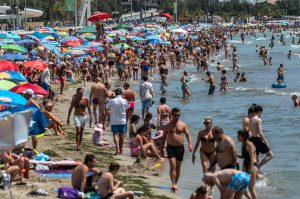If you pick a famous European city for your summer vacation, you’re likely signing up for congested airports, attractions, and TikTok-famous restaurants.
You probably also have to snap up your holiday rental before one of the hundred others eyeing it doesn’t beat you to it.
That’s a sign you’ve encountered an effect of overtourism.
Travel is a phenomenon as old as time. Historically, it was seen as a positive experience where visitors engaged with a country’s culture and boosted the local economy by supporting businesses. It was seen as a rare, once-in-a-lifetime opportunity that often took months of planning. Lately, however, travel has become easy and affordable—and that’s tipped the scales towards overtourism, changing people’s experience for the worse and degrading residents’ quality of life.
Anti-tourism protests in Europe started in the 1990s with “touristification” of culturally significant places. In recent months, authorities and locals have become noticeably bitter about the uptick in visitors. In Barcelona, protesters sprayed water and screamed “go home” at tourists earlier this month, highlighting how the tourism industry’s impact often overflows into residents’ lives. The Spanish city welcomed nearly 26 million visitors last year—roughly 16 times its population of 1.6 million.

An anti-tourism placard during a protest in Barcelona, Spain.
Paco Freire—SOPA Images/LightRocket/Getty Images
Protestors in Mallorca in May called for a more sustainable form of tourism that prioritizes locals’ ability to buy property and imposes controls on holiday stays. Such protests could spread further, a top UNESCO official warned, if the right action isn’t taken to nip the problem.
“Tourism is dying of success in some of the destinations. No famous destination that [is] overcrowded has found the formula to avoid this phenomenon of overtourism,” said Manuel Alector Ribeiro, an associate professor in tourism management at the University of Surrey. He thinks there’s a lack of management as “tourism is supposed to be an industry or sector for social good,” instead, it’s breeding hostility between residents and tourists.
Cities have tried to tread lightly, given their complicated relationship with tourism. On the one hand, it’s a significant revenue contributor to local finances. For instance, travel and tourism directly contributed to 7.7% of Venice’s GDP in 2022, according to the World Travel & Tourism Council. On the other, the visitor boom has made housing exorbitant, with more places catering to short-term stays over long-term rentals, ultimately pricing locals out.
People’s attitudes towards tourism have also changed with time. A majority of Barcelona residents don’t see tourism as much of an economic driver as they did before and think the city has reached its limit, a 2023 city council survey revealed. The report also found that locals resist cheap tourism which makes travel more attractive—but at what cost?
How did we end up here?
Mass tourism has been building up for a while now. A confluence of post-pandemic travel demand, strong U.S. dollar against the euro, and higher disposable income in countries like India and China have contributed to it. But at the center of it is the access to affordable flights, Boston Consulting Group’s managing director and partner Yassin El Khourouj told Fortune.
“The rise of low-cost airlines has allowed the development of cheap city breaks and short trips. In parallel, in most cases, overtourism has yet to be properly addressed by destination authorities,” he said. Discount airlines offer double-digit fares to different parts of Europe, making impromptu weekend trips to Barcelona, Bordeaux and more, possible.
He added that the sprawling short-term rental business, such as Airbnb, have made stays at the heart of historic cities within reach.
Overtourism has become a hot topic in European cities this summer because it’s reached a tipping point, and residents are increasingly bearing the brunt of it. This could look different depending on the destination.
For instance, more restaurants could serve international food instead of local food or there may be more souvenir stores that threaten the “authenticity” of neighborhoods, Khourouj said. Locals also face safety concerns and higher noise pollution if they live near popular areas due to overtourism.

Stefano Mazzola—Getty Images
The impact goes beyond just social factors. Parts of Europe, such as Sicily and Barcelona, have been facing water shortages amid rising temperatures, forcing them to curb visitor numbers or ration water usage. Mass tourism can also result in environmental deterioration through more waste and pollution. Amsterdam plans to ban cruises in the next few years as they drive up emissions in the city.
Unfortunately, as tourists typically make pit stops at different destinations for a few days at best, they aren’t fully aware of the impact they’re having.
“Many visitors arrive in their destinations on a package holiday or cruise. They’re somewhat insulated from the places they’re visiting and in general I’d say awareness [of their impact] is low,” Simon Lynch, the global sales and product director at tour operator Scott Dunn, told Fortune.
But it’s starting to weigh on their decisions as they consider off-season travel more or opt for off-beat locations.
To be sure, tourism has immense benefits in areas such as job creation and infrastructural improvements. In the Portuguese town of Porto, the local authorities see a trend of repeat tourists as a way to regenerate the city and revive it to new glory.
It comes down to promoting a more measured form of tourism that puts residents and the city first while still encouraging visitors.
Changing gears
Cities have started acting against mass tourism in various ways, such as banning cruises and capping crowds at popular sites. Barcelona announced a short-term rental ban in 2028 to stem its housing crisis. Venice, Athens, and Amsterdam have also grappled with overtourism and tried to counter it by introducing entry fees for attractions and capping new hotel constructions.
Bruges’s “hotel stop” model limits where hotels are constructed to promote livability in the city and its outskirts.
Spreading tourists out in different parts of a city or country can mean a more enjoyable experience for all, Ribeira said. Government policies should aim to create benefits that can translate to an “increase in the quality of life and well-being of the people who live in the destinations,” he added.

John Keeble—Getty Images
Elsewhere in Europe, authorities are trying to make tourism a positive force by encouraging visitors to help with the city’s clean-up in exchange for free access to attractions.
Scott Dunn’s Lynch pointed out that authorities should stop promoting the “Instagram hot spots” that create more chaotic city centers. London’s 90-day cap on short-term rentals in a year aims to balance tourism demand with long-term rental needs. Involving local communities in policy decisions could also help cities find a more sustainable way to manage the influx of visitors during peak seasons.
“Ultimately, it’s about creating a high-quality experience for visitors and maintaining a high-quality environment for residents,” Lynch said. “Deterring tourists isn’t the answer.”
Recommended Newsletter:
CEO Daily provides key context for the news leaders need to know from across the world of business. Every weekday morning, more than 125,000 readers trust CEO Daily for insights about–and from inside–the C-suite. Subscribe Now.
>>> Read full article>>>
Copyright for syndicated content belongs to the linked Source : Fortune – https://fortune.com/europe/2024/07/20/affordable-travel-europe-overtourism-social-environment-cities-barcelona-amsterdam-athens-airports-tiktok-trends/































